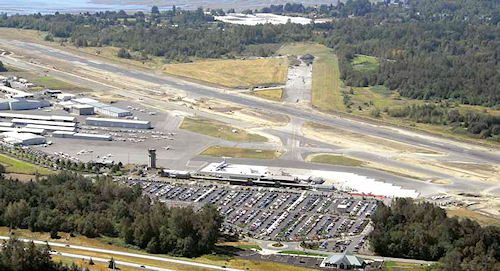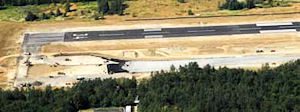
 On Aug. 31, Bellingham International Airport (BLI) in Washington shut down its only runway for extensive rehabilitation at 11 p.m. Twenty-two days and 70,000 tons of asphalt later, a Horizon Air flight lifted off its new runway at 5:20 a.m. – despite unseasonably wet weather, even by Pacific Northwest standards.
On Aug. 31, Bellingham International Airport (BLI) in Washington shut down its only runway for extensive rehabilitation at 11 p.m. Twenty-two days and 70,000 tons of asphalt later, a Horizon Air flight lifted off its new runway at 5:20 a.m. – despite unseasonably wet weather, even by Pacific Northwest standards.
|
Facts & Figures Project: Runway Rehab & Taxiway Reconstruction Location: Bellingham (WA) International Airport Cost: $29 million Funding: 95% FAA, 5% airport passenger fees Design & Engineering: URS Corp. General Contractor: ICON Materials Subcontractors Electrical/Instrumentation: Elcon Corporation Surveying: Pacific Surveying and Engineering Services Pavement Milling: PR Systems Storm Pipe Boring: NW Boring Co. Trucking & Materials Supply: Cowden Gravel & Ready Mix Hydroseeding: Allstar Hydroseeding Pavement Markings: Hicks Striping & Curbing Security Fencing: Guyline Construction Runway Grooving: Penhall Company Electrical Components: ADB Airfield Solutions Geotextile: Propex Geosynthetics Geogrid: Tensar International Corp. Details: Phased reconstruction and widening of taxiway to keep runway open; closure and complete rehabilitation of 6,700-foot runway in 22 days |
Putting down roughly 70,000 tons of P-401 asphalt mix with PG 70-22 asphalt binder in 22 days is difficult even in good weather, notes David Gent, project manager for general contractor ICON Materials. According to Gent, the high-grade polymer modified asphalt is the toughest spec the company has had to meet.
 On the Rise
On the Rise
Over the past five years, traffic at Bellingham International has grown between 17% and 24% every year – a noteworthy trend given the declines at most other airports.
About 20 miles from the Canadian border, the airport sits in a hot, largely untapped, market. In 2004, Allegiant Air started direct flights from Bellingham International to Las Vegas, and quickly added five other routes based on its initial success. Alaska Airlines also started flying direct to Las Vegas from Bellingham International. Both airlines attract price-conscious travelers from across the border in British Columbia who are looking to avoid Canada’s Harmonized Sales Tax and beat fares at Vancouver International Airport.
“For a Canadian flying out of Vancouver to Las Vegas, the ticket may cost $600,” says Zenk. “That same traveler can cross the border and fly from Bellingham to Las Vegas for $200 to $250.”
Interestingly, Zenk relates, the FAA only recognizes 3% forecasted growth at Bellingham International. Over the past five years, the airport has had to update its forecast four times because the FAA didn’t believe it was growing at the 17% to 24% rate the airport projected.
Despite the FAA’s doubts, Zenk expects the 17% to 18% growth to continue for the next year or so. “Starting in January 2011, Alaska Airlines will be flying to Hawaii from Bellingham,” he reports.
Amid the growth, the airport’s runway and taxiway hadn’t been rehabbed in more than 20 years, and they struggled to handle the larger and heavier B-737s and MD-80s the airport was attracting. “The heavier aircraft were tearing up the runway,” Zenk recalls. “We were putting on Band-Aid patches to stay in operation until we could get funding.”
When planning the recently completed rehab, airport officials selected an asphalt mix one step above the FAA standard to accommodate the larger aircraft. Funding for the $29 million runway and taxiway project finally came through in early 2010. The FAA provided 95% of the cost; airport passenger fees will cover the remaining 5%.
A $29 million runway rehabilitation project is helping Bellingham Int’l handle the larger, heavier aircraft it has been attracting.
Planning & Coordination

The airport broke ground for reconstruction of Taxiway Alpha in April 2010. Work proceeded in increments to allow the 6,700-foot runway to remain in operation until Aug. 31.
“Because the airport sits along the coast where the soil base is poor, the old taxiway had to be completely demolished,” says Shammi Ratti, project manager for engineering and design consultant URS Corp. Crews widened the taxiway from 60 feet to 75 feet to handle Group IV aircraft in preparation for the 757s and possibly 767s that will be flying to/from Hawaii.
The taxiway underwent full-depth reconstruction, Ratti explains. Layers of geofabric and geogrid were placed over the subgrade, followed by 18 inches of quarry spalls, six inches of crushed surface base course and 10 inches of asphalt to achieve the final grade. Soft areas of the taxiway were over-excavated an additional 16 inches and replaced with quarry spalls to provide additional stability.
Advance communication with contractors is key for a project of this scope, emphasizes Ratti. To give potential bidders a heads-up on the project, URS helped the airport hold an open house in January 2010, when design for the project was about 60% complete.
“This was a huge project, and Bellingham is not a metropolis,” Ratti explains. “With a 22-day runway closure period, we had to come up with some creative ways to encourage the bidding community to participate as well as modify and calibrate our plans and construction documents for the contracting community in the area.”
The airport advertised the open house in local newspapers and trade periodicals for contractors, subcontractors and suppliers. Approximately 60 people attended and were briefed on the project and the potential quantities of materials that would be needed. With this information, potential contractors and suppliers were able to evaluate their ability to meet the demands of the project and gear up their teams before the bidding took place.
Crews widened the airport’s taxiway to accomodate the 757s and possibly 767s flying to and from Hawaii.
Meeting the Deadline

In preparation for the runway work, crews spent June and July burying perforated HDPE underdrains approximately 21/2 feet below the surface, running parallel to the runway.
“We knew we were going be placing a tremendous amount of asphalt on top of the existing runway,” Ratti explains. “By putting the underdrains in early, the runway base had a couple of months to dry out before we started moving out the heavy equipment. It’s an effective way to create a stable platform to work on.”
As the runway closure date approached, two demolition crews, three grading crews and three paving crews were staged, so work could begin as soon as the field was cleared. Working 24/7, they started by milling off the top four inches of asphalt and replacing it with new asphalt. In some areas, the runway had to be leveled with 39 inches of new asphalt to remedy the rollercoaster dips that had formed. After the runway was leveled to grade, four inches of P-403 and another five inches of P-401 asphalt mix were laid on top, effectively raising the runway nine inches above the old grade.
To facilitate drainage, a 320-foot long, 52-inch diameter storm pipe was installed beneath the runway. Boring the opening for the drainpipe, recalls Ratti, was “quite an operation” that cost $750,000.
In addition to the runway and taxiway work, the airfield’s old electrical system was completely replaced. New edge lights and signs were installed and a new medium-intensity approach lighting system with runway alignment was added. A new precision approach path indicator system replaced the old visual approach slope indicator system, and the airport control tower received a new airfield lighting control system. Wind cones were also upgraded and repositioned to increase visibility.
Given the short timeline and tremendous quantities of materials involved, Ratti feels the project was “very rewarding” from an engineering standpoint.
For Zenk, the changes have been dramatic. “It feels like a completely new airport,” he reports.


